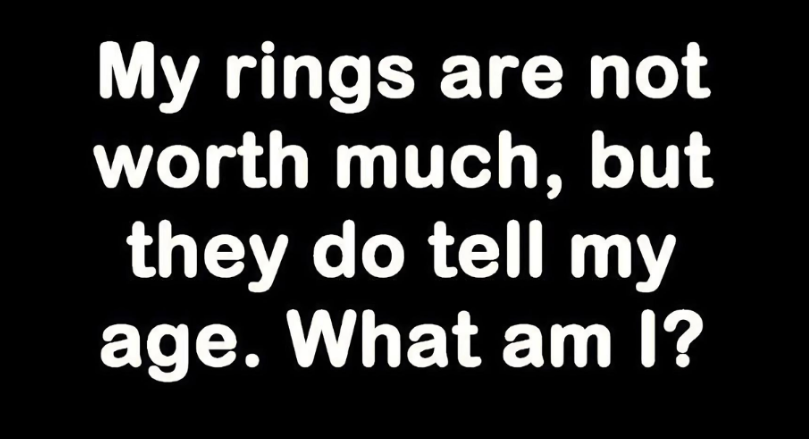Riddles have long been a delightful way to engage the mind, testing our ability to think beyond the obvious. Today, we’ll explore a timeless riddle that often leaves many scratching their heads:
At first glance, this might seem perplexing, but with a bit of reflection, the answer becomes clear. Let’s break down this riddle and walk through the thought process to arrive at the correct conclusion.

Step 1: Analyzing the Clue About Rings
The key to solving this riddle lies in the first clue: “My rings are not worth much.” Right away, this should steer us away from thinking about valuable jewelry, like gold or silver rings. It’s tempting to imagine something ornate, but these rings are not about monetary value. Instead, we need to think about other types of rings—ones that may not have any material worth but hold significant meaning.
Step 2: The Purpose of the Rings
The next part of the riddle gives us an important insight: these rings tell age. This is where the solution begins to unfold. What kind of rings could be associated with telling age? Clearly, these rings are not the type you wear on your fingers, but rather something naturally occurring—rings that grow or accumulate over time, offering a clear indication of how old something is.
Step 3: Shifting Perspective – Think Nature
If we shift our thinking from the artificial world of jewelry to the natural world, we start to see the answer. In nature, there is one very common object that grows rings as it ages, and those rings tell its exact age. Can you guess what it is?
The Answer: A Tree
The correct answer to the riddle is a tree. When you cut a tree crosswise, the trunk reveals a series of rings, each representing a year of growth. By counting these rings, you can determine the tree’s age. These rings are not of any monetary value, but they are incredibly significant because they tell the tree’s life story. Each ring symbolizes a year of life, capturing periods of drought, rain, or even fire.
Now that we’ve cracked the riddle, let’s delve into a bit of the science behind tree rings. Tree rings, also known as growth rings or annual rings, form as a tree grows. Each year, a tree adds a new layer of wood under its bark, forming a ring. The thickness and appearance of the ring can vary depending on environmental conditions, such as rainfall or temperature, during that particular year.
Here’s why tree rings are fascinating:
- Annual Growth: Each ring typically represents one year of growth.
- Environmental History: By studying the rings, scientists can learn about the climate conditions during each year of the tree’s life. Thicker rings usually indicate a year of abundant resources (like rain), while thinner rings may suggest drought.
- Longevity: Trees can live for hundreds or even thousands of years, making their rings a long-term record of environmental history.
Additionally, the riddle plays on our tendency to think of “age” as something tied to humans or animals. But age can apply to many things in the natural world, including plants. By challenging us to make this cognitive leap, the riddle opens up new ways of thinking about familiar concepts.
So, if you ever hear the riddle, “My rings are not worth much, but they do tell my age,” you’ll know the answer is a tree. It’s a wonderful reminder of the natural world’s subtle, enduring way of keeping time. The rings in a tree are far more valuable than any jewelry because they hold the history of the world within them.
Riddles like these not only sharpen our minds but also offer a chance to reflect on the beauty of nature and how something as simple as a tree’s rings can tell an entire life story. So, the next time you’re in a forest, take a moment to appreciate the trees around you—they’ve been counting the years all along.


